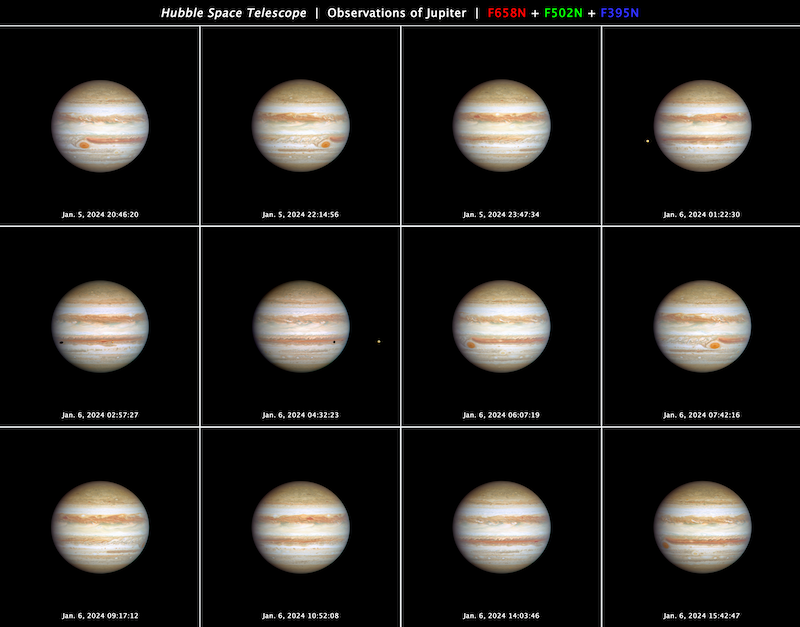- New images of Jupiter from the Hubble Space Telescope the whole of the gas giant as it rotates. These images provide insights into Jupiter’s stormy weather patterns.
- Jupiter’s weather is intense, due the fact that its atmosphere is tens of thousands of miles deep with no solid surface beneath. The thick jovian atmosphere hosts big and little storms, including cyclones and anticyclones, some larger than Earth.
- The new images show Jupiter’s famous Great Red Spot, plus what scientists call Red Spot Jr., a smaller anticyclone that brushes past the Great Red Spot about every two years.
Hubble watches Jupiter’s stormy weather
Jupiter – biggest planet in our solar system – is a dynamic world! Its deep atmosphere is constantly churning with cyclones, wind shear and other violent storms. The Great Red Spot is the largest and most well-known of Jupiter’s storms. And Jupiter is also famous for its distinct red-and-tan cloud bands, which you can see even in small telescopes. On March 14, 2024, NASA released new images of the gas giant planet, taken by the Hubble Space Telescope. Hubble has been busy tracking Jupiter’s stormy weather. The new images, taken on January 5-6, 2024, show both hemispheres of this mighty world, as it spins on its axis once about every 10 hours.
Hubble took the images as part of the Outer Planet Atmospheres Legacy program (OPAL). In OPAL, Hubble monitors all the giant planets – Jupiter, Saturn, Uranus and Neptune – and their weather systems every year. Scientists call it Hubble’s Grand Tour of the Outer Solar System. Unlike the smaller rocky planets (with the exception of Venus), these gas and ice giants are completely blanketed by deep, turbulent atmospheres. Ferocious winds churn up the clouds and hazes. Hence, weather patterns are always changing, and scientists want to keep track of the changes.
On Jupiter in particular, storms of various sizes – some much larger than Earth – churn in the atmosphere. These include both cyclones and anticyclones, rotating in opposite directions to each other. This shows that there are high-pressure and low-pressure weather systems that sometimes interact with each other.
Help spread the wonders of astronomy! Please donate now to EarthSky.org and ensure that people around the world can learn about the night sky and our universe.
The new images in detail
Indeed, there is much to see in the new images. In the left image above, you can easily see Jupiter’s Great Red Spot, even though it has been gradually shrinking in size. To its lower right is Red Spot Jr., a much smaller anticyclone. It formed when two other storms merged together in 1998 and 2000. Its color has varied over the years as well. It was distinctly red in 2006, then became paler. Now, in 2024, it looks redder again.
The Great Red Spot and Red Spot Jr. don’t collide, but they do pass each other about every two years.
Bouncing and repelling storms
And there’s more! The right image, above, shows the opposite hemisphere of Jupiter as it rotated into view. Another cyclone and anticyclone appear close together, both deeply red in color. The cyclone features an upwelling of clouds on the edges. Other clouds are descending in the middle of the cyclone. This causes a clearing in the otherwise obscuring atmospheric haze. Scientists say these storms should bounce past and repel each other, because they’re rotating in opposite directions. OPAL project lead Amy Simon at NASA’s Goddard Space Flight Center in Greenbelt, Maryland, said:
The many large storms and small white clouds are a hallmark of a lot of activity going on in Jupiter’s atmosphere right now.

This video shows a full rotation of Jupiter for OPAL 2024. Hubble snapshots of the planet, taken January 5-6, 2024, have been photo-mapped onto a sphere, and the model is then rotated in animation. Video via NASA/ ESA/ Amy Simon (NASA-GSFC)/ Joseph DePasquale (STScI).
In addition, you can see Jupiter’s volcanic moon Io to the left of the planet in the right image. In fact, Io is the most volcanically active known body in the solar system, even more than Earth.
Deep, turbulent atmosphere
Jupiter’s atmosphere is tens of thousands of miles deep, with no solid surface below. And, along with the other storms, there are also clouds of ammonia ice crystals. By comparison, they are only about 30 miles (48 km) thick. These clouds also give Jupiter its banded appearance. In the bands, air is flowing up to almost 350 miles per hour (560 km/h) in different directions and at various latitudes.
Last January, the ESPRESSO planet-hunter also turned its gaze to Jupiter, capturing some stunning views. ESPRESSO is the spectrograph on the Very Large Telescope (VLT) in Chile, designed primarily to look for exoplanets.
And, speaking of Jupiter, have you seen these photos of the moon and Jupiter together? EarthSky readers took these images on March 13 and 14, 2024.
Bottom line: NASA’s Hubble Space Telescope has sent back new images of Jupiter’s stormy weather. Hubble monitors the atmospheres of all the giant planets every year.
Via Hubblesite/NASA
Read more: The ESPRESSO planet-hunter looks at Jupiter
Read more: Jupiter’s moon Io as you’ve never seen it